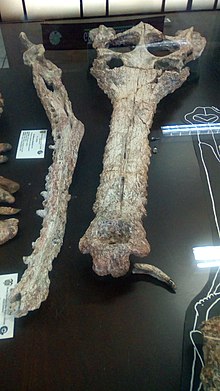Gryposuchus
| Gryposuchus | |
|---|---|

| |
| Fossils of the skull and mandible of G. colombianus, Museo Geológico José Royo y Gómez, Bogotá. | |
| Scientific classification | |
| Domain: | Eukaryota |
| Kingdom: | Animalia |
| Phylum: | Chordata |
| Class: | Reptilia |
| Clade: | Archosauromorpha |
| Clade: | Archosauriformes |
| Order: | Crocodilia |
| Family: | Gavialidae |
| Subfamily: | †Gryposuchinae |
| Genus: | †Gryposuchus Gurich, 1912 |
| Type species | |
| †Gryposuchus jessei Gurich, 1912
| |
| Other species | |
| |
Gryposuchus is an
Species
The
Another species, G. colombianus, has been recovered from deposits from the Middle Miocene

A species described in 2008, G. croizati, also found from the upper Miocene Urumaco Formation in Venezuela,[2] can be distinguished from other species of Gryposuchus on the basis of a reduced number of maxillary teeth, a slender parietal interfenestral bar, and widely separated and reduced palatine fenestrae, and other characters. Based on measurements of the orbital cranial skeleton, the length of the animal has been estimated at around 10.15 metres (33.3 ft) in length, with a total mass of about 1,745 kilograms (3,847 lb). Measuring the entire length of the skull from the end of the rostrum to the supraoccipital would result in a much larger size estimate, up to three times as great. However, because there is considerable variation seen in rostral proportions among crocodilians, the latter measurements are probably not an accurate way of estimating body mass and length.[11] Despite this, the species is still one of the largest crocodilians known to have existed, and it may indeed have been the largest gavialoid to have ever existed if a recent revision in the estimated size of the large tomistomine Rhamphosuchus is correct (the genus was once considered to be 15 metres (49 ft) in length; the new estimate puts it at approximately 10 metres (33 ft)).[12]
Some skull material also recovered from Peruvian Amazon (Iquitos) in the
Indeterminate finds of Gryposuchus were noted from the early Miocene
Phylogeny
A
Alternatively, a 2018
| Gavialidae |
|
Gryposuchinae | ||||||||||||||||||||||||||||||||||||||||||||||||||||||||||||
Paleoecology
The Miocene epoch represents the only history of gavialoids (solely of the subfamily Gryposuchinae) in South America, from a Caribbean launchpad (Aktiogavialis from the Middle Oligocene of Puerto Rico,[16] and Dadagavialis from the Early Miocene of Panama).[18] Although there were six other confirmed genera of gryposuchine, Gryposuchus was almost certainly the most successful, with an existence potentially encompassing almost all of the Miocene, and a range from Venezuela to Argentina in the Middle to Late Miocene. This dominance was likely due to the fact that Gryposuchus was one of only two freshwater adapted gryposuchines (other than Hesperogavialis),[19] whereas the others (such as Siquisiquesuchus and Piscogavialis) were either primarily estuarine, coastal or marine based predators.[20][21] This would certainly have been useful in taking advantage of the extensive continental waterways and swamps of what would become the Amazon basin. Gryposuchus can be observed far and wide, from coastally adjacent and inclusive formations, such as the Urumaco Formation of Venezuela,[22][23] to even beyond the northern drainage basins, into Argentina.[5] This is in contrast with almost all the other species within the subfamily, which are limited to certain time periods near or on coast, with only Hesperogavialis penetrating into Brazil in the Late Miocene.
Although Gryposuchus had already reached Argentina by the Middle Miocene,
References
- PMID 34567843.
- ^ S2CID 134902094.
- ^ S2CID 52976475.
- ^ a b Langston, W.; Gasparini, Z. (1997). "Crocodilians, Gryposuchus, and the South Americans gavials". In Kay, R.F.; Madden, R.H.; Cifelli, R.L.; Flynn, J.J. (eds.). Vertebrate Paleontology in the Neotropics: The Miocene Fauna of La Venta, Colombia. Washington: Smithsonian Institution. pp. 113–154.
- ^ S2CID 131646050.
- ^ Burmeister, G. (1885). "Examen crítico de los mamíferos y los reptiles denominados pot Don Augusto Bravard". Anales del Museo Púbtico de Buenos Aires. 3: 95–173.
- .
- ^ Langston, W. (1965). "Fossil crocodilians from Colombia and the Cenozoic history of the Crocodilia in South America". University of California Publications in Geological Sciences. 52: 1–152.
- ^ Salas-Gismondi, R.; Antoine, P. O.; Baby, P.; Brusset, S.; Benammi, M.; Espurt, N.; de Franceschi, D.; Pujos, F.; Tejada, J.; Urbina, M (2007). "Middle Miocene crocodiles from the Fitzcarrald Arch, Amazonian Peru". In Díaz-Martínez, E.; Rábano, I. (eds.). 4th European Meeting on the Palaeontology and Stratigraphy of Latin America. Cuadernos del Museo Geominero. Vol. 8. Madrid: Instituto Geológico y Minero de España.
- .
- S2CID 85172486.
- ^ Head, J. J. (2001). "Systematics and body size of the gigantic, enigmatic crocodyloid Rhamphosuchus crassidens, and the faunal history of Siwalik Group (Miocene) crocodylians". Journal of Vertebrate Paleontology. 21 (Supplement to No. 3): 59A.
- ^ PMID 27097031.
- ^ S2CID 130332367.
- ISSN 0024-4082.
- ^ PMID 17341454.
- PMID 30051855.
- S2CID 91495532.
- ^ Kay, R. F. and Madden, R. H. (1997). Paleogeography and paleoecology. In: Kay, R. F., Madden, R. H, Cifelli, R. L., and Flynn, J. J., eds., Vertebrate paleontology in the neotropics: the Miocene fauna of La Venta, Colombia. Smithsonian Institution Press; Washington, DC. pp. 520–550.
- S2CID 84214781.
- ^ Brochu, C. A.; Rincon, A. D. (2004). "A gavialoid crocodylian from the Lower Miocene of Venezuela". Special Papers in Palaeontology. 71: 61–78.
- ^ Linares, O. J. (2004). "Bioestratigrafia de la fauna de mamiferos de las Formaciones Socorro, Urumaco y Codore (Mioceno Medio–Plioceno Temprano) de la region de Urumaco, Falcon, Venezuela". Paleobiologia Neotropical. 1: 1–26.
- S2CID 84357359.
- ^ "Fourteen closely related crocodiles existed around 5 million years ago". ScienceDaily. Retrieved 2020-04-19.

